engine Seat Leon 5D 2011 Owner's Guide
[x] Cancel search | Manufacturer: SEAT, Model Year: 2011, Model line: Leon 5D, Model: Seat Leon 5D 2011Pages: 302, PDF Size: 4.17 MB
Page 91 of 302

89
Cockpit
Electronic Stability Control ESC (ESP) * οΆ / ο«
There are two control lamps for the electronic stability con-
trol. The οΆ lamp provides information concerning the func-
tion and the ο« provides information on the disconnection
status
Both lamps come on together when the ignition is switched on and should
go out after approx. 2 seconds, which is how long the function check lasts.
This programme includes the ABS, EDL and ASR (TCS). This also includes
the brake assist system (BAS), automatic cleaning of the brake discs and
the trailer stability programme (TSP).
The warning lamp οΆ has the following functions: β It flashes when the ASR (TCS)/ESC (ESP) is activated when driving.
β It will light up continuously if there is a malfunction in the ESC (ESP).
β The ESC (ESP) lamp will also come on if a fault should occur in the ABS
because the ESC (ESP) operates in conjunction with the ABS.
If the ESP warning lamp οΆ lights up and stays on after the engine is started,
this may mean that the control system has temporarily switched off the ESP.
In this case the ESC (ESP) can be reactivated by switching the ignition off
and then on again. If the warning lamp goes out, this means the system is
fully functional.
The ο« lamp provides information about the disconnection status of the
system:
β It stays lit when the ASR (TCS) is disconnected after pressing the ο«
switch. οDifferential lock fault (EDL)*EDL operates along with the ABS in vehicles equipped with
the Electronic Stability Control ESC (ESP)*
A malfunction in the EDL is indicated by the ABS warning lamp οͺ. Take the
vehicle to a specialised workshop as soon as possible. For further informa-
tion on the EDL see ββpage 185, Electronic differential lock (EDL)*. ο
Traction control system ASR (TCS)* οΆ / ο«
The traction control system prevents the driven wheels from
spinning when the vehicle is accelerating
There are two warning lamps for the traction control system: οΆ and ο«. Both
lamps come on together when the ignition is switched on and should go out
after approx. 2 seconds, which is how long the function check lasts.
The οΆ lamp has the following function:
β It flashes when the ASR (TCS) is activated while driving.
If the system is deactivated or if it has any fault, the warning lamp will re-
main lit. The ASR (TCS) lamp will also come on if a fault should occur in the
ABS because the ASR (TCS) operates in conjunction with the ABS. For fur-
ther information, see ββ page 182, Brakes
The ο« lamp provides information about the disconnection status of the
system:
β It stays lit when the ASR (TCS) is disconnected after pressing the OFF
switch.
By pressing again, the ASR (TCS) function is reactivated and the warning
lamp switched off. ο
Safety FirstOperating InstructionsPractical TipsTechnical Specifications
Page 92 of 302

90Cockpit
Operating the foot brake ο«
The brake pedal must be depressed when this warning lamp lights up. This
is necessary when the automatic gearbox* selector lever is moved out of the
positions P or N. ο
Electronic immobiliser* βSafeβ
This warning lamp flashes if an unauthorised key is used.
Inside the key there is a chip that deactivates the electronic immobiliser au-
tomatically when the key is inserted into the ignition. The immobiliser will
be activated again automatically as soon as you pull the key out of the igni-
tion lock.
The instrument panel displays the following message 1)
: SAFE. The vehicle
cannot be used in that case ββpage 160.
The engine can, however, be started if the appropriate coded SEAT genuine
key is used.
Note
A perfect operation of the vehicle is ensured if genuine SEAT keys are used. ο
1)
Depending on the version of the model.
Page 99 of 302
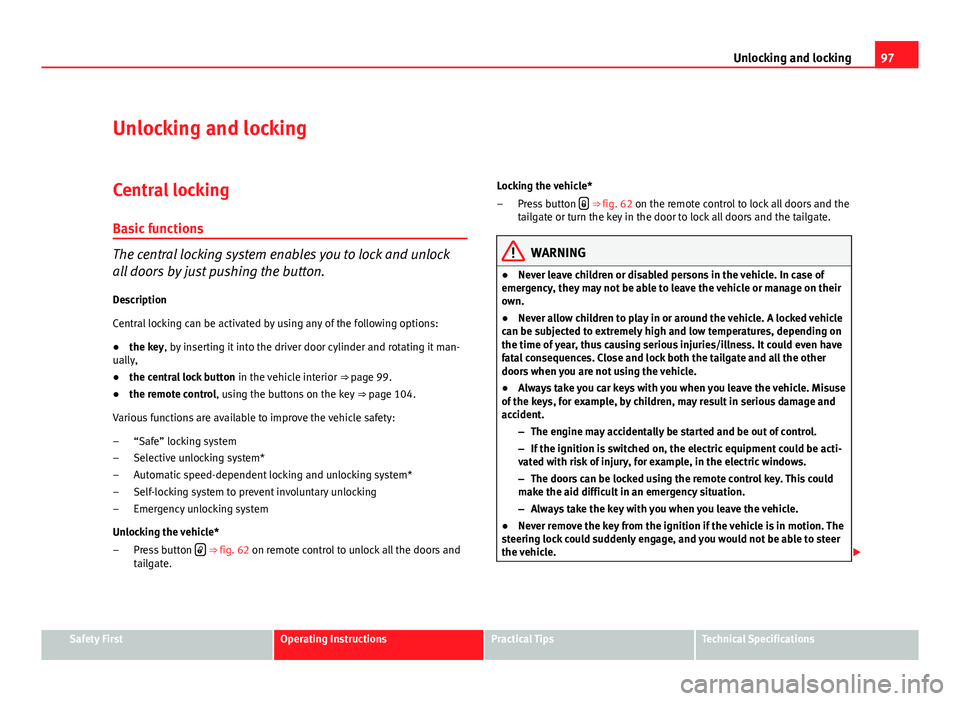
97
Unlocking and locking
Unlocking and locking
Central locking Basic functions
The central locking system enables you to lock and unlock
all doors by just pushing the button.Description
Central locking can be activated by using any of the following options:
β the key, by inserting it into the driver door cylinder and rotating it man-
ually,
β the central lock button in the vehicle interior ββpage 99.
β the remote control, using the buttons on the key ββpage 104.
Various functions are available to improve the vehicle safety: βSafeβ locking system
Selective unlocking system*
Automatic speed-dependent locking and unlocking system*
Self-locking system to prevent involuntary unlocking
Emergency unlocking system
Unlocking the vehicle* Press button ο
ββfig. 62 on remote control to unlock all the doors and
tailgate.
β
β
β
β
β
β Locking the vehicle*
Press button ο
ββ
fig. 62 on the remote control to lock all doors and the
tailgate or turn the key in the door to lock all doors and the tailgate.
WARNING
β Never leave children or disabled persons in the vehicle. In case of
emergency, they may not be able to leave the vehicle or manage on their
own.
β Never allow children to play in or around the vehicle. A locked vehicle
can be subjected to extremely high and low temperatures, depending on
the time of year, thus causing serious injuries/illness. It could even have
fatal consequences. Close and lock both the tailgate and all the other
doors when you are not using the vehicle.
β Always take you car keys with you when you leave the vehicle. Misuse
of the keys, for example, by children, may result in serious damage and
accident.
βThe engine may accidentally be started and be out of control.
β If the ignition is switched on, the electric equipment could be acti-
vated with risk of injury, for example, in the electric windows.
β The doors can be locked using the remote control key. This could
make the aid difficult in an emergency situation.
β Always take the key with you when you leave the vehicle.
β Never remove the key from the ignition if the vehicle is in motion. The
steering lock could suddenly engage, and you would not be able to steer
the vehicle. ο£
β
Safety FirstOperating InstructionsPractical TipsTechnical Specifications
Page 105 of 302
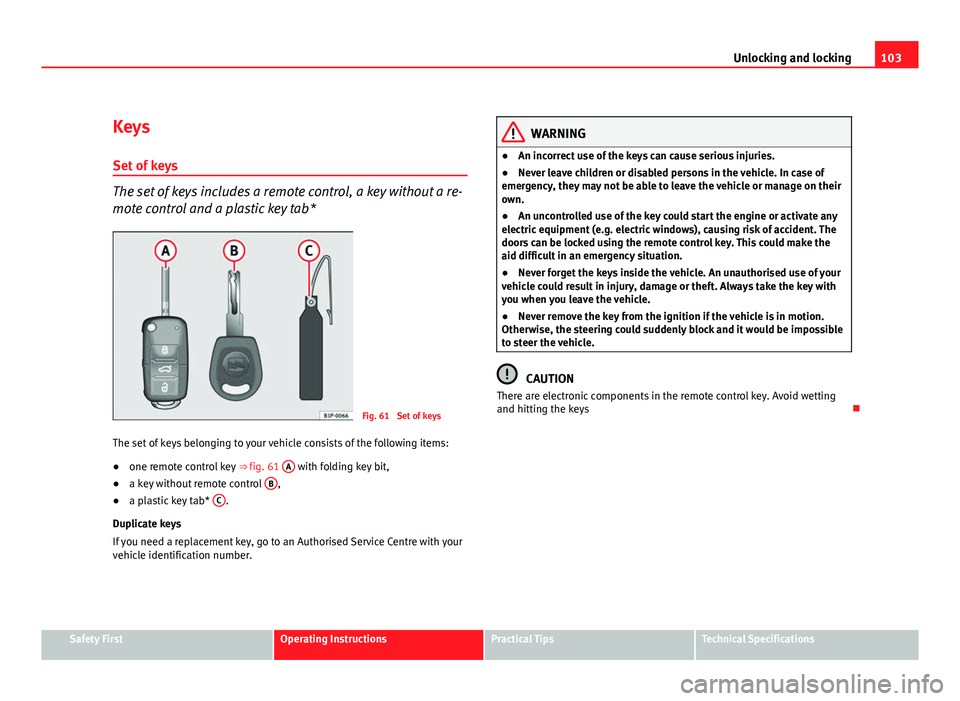
103
Unlocking and locking
Keys
Set of keys
The set of keys includes a remote control, a key without a re-
mote control and a plastic key tab*
Fig. 61 Set of keys
The set of keys belonging to your vehicle consists of the following items:
β one remote control key ββfig. 61 A
with folding key bit,
β a key without remote control B,
β a plastic key tab* C.
Duplicate keys
If you need a replacement key, go to an Authorised Service Centre with your
vehicle identification number.
WARNING
β An incorrect use of the keys can cause serious injuries.
β Never leave children or disabled persons in the vehicle. In case of
emergency, they may not be able to leave the vehicle or manage on their
own.
β An uncontrolled use of the key could start the engine or activate any
electric equipment (e.g. electric windows), causing risk of accident. The
doors can be locked using the remote control key. This could make the
aid difficult in an emergency situation.
β Never forget the keys inside the vehicle. An unauthorised use of your
vehicle could result in injury, damage or theft. Always take the key with
you when you leave the vehicle.
β Never remove the key from the ignition if the vehicle is in motion.
Otherwise, the steering could suddenly block and it would be impossible
to steer the vehicle.
CAUTION
There are electronic components in the remote control key. Avoid wetting
and hitting the keys ο
Safety FirstOperating InstructionsPractical TipsTechnical Specifications
Page 107 of 302
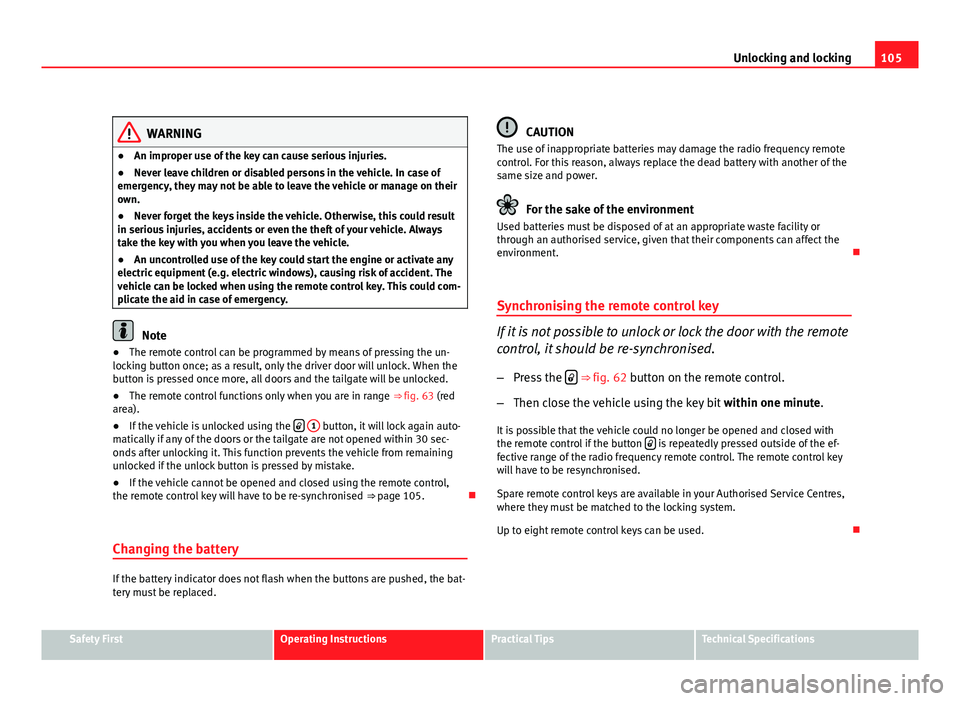
105
Unlocking and locking
WARNING
β An improper use of the key can cause serious injuries.
β Never leave children or disabled persons in the vehicle. In case of
emergency, they may not be able to leave the vehicle or manage on their
own.
β Never forget the keys inside the vehicle. Otherwise, this could result
in serious injuries, accidents or even the theft of your vehicle. Always
take the key with you when you leave the vehicle.
β An uncontrolled use of the key could start the engine or activate any
electric equipment (e.g. electric windows), causing risk of accident. The
vehicle can be locked when using the remote control key. This could com-
plicate the aid in case of emergency.
Note
β The remote control can be programmed by means of pressing the un-
locking button once; as a result, only the driver door will unlock. When the
button is pressed once more, all doors and the tailgate will be unlocked.
β The remote control functions only when you are in range ββfig. 63 (red
area).
β If the vehicle is unlocked using the ο
1 button, it will lock again auto-
matically if any of the doors or the tailgate are not opened within 30 sec-
onds after unlocking it. This function prevents the vehicle from remaining
unlocked if the unlock button is pressed by mistake.
β If the vehicle cannot be opened and closed using the remote control,
the remote control key will have to be re-synchronised ββpage 105.ο
Changing the battery
If the battery indicator does not flash when the buttons are pushed, the bat-
tery must be replaced.
CAUTION
The use of inappropriate batteries may damage the radio frequency remote
control. For this reason, always replace the dead battery with another of the
same size and power.
For the sake of the environment
Used batteries must be disposed of at an appropriate waste facility or
through an authorised service, given that their components can affect the
environment. ο
Synchronising the remote control key
If it is not possible to unlock or lock the door with the remote
control, it should be re-synchronised.
β Press the ο
ββfig. 62 button on the remote control.
β Then close the vehicle using the key bit within one minute.
It is possible that the vehicle could no longer be opened and closed with
the remote control if the button ο
is repeatedly pressed outside of the ef-
fective range of the radio frequency remote control. The remote control key
will have to be resynchronised.
Spare remote control keys are available in your Authorised Service Centres,
where they must be matched to the locking system.
Up to eight remote control keys can be used. ο
Safety FirstOperating InstructionsPractical TipsTechnical Specifications
Page 112 of 302
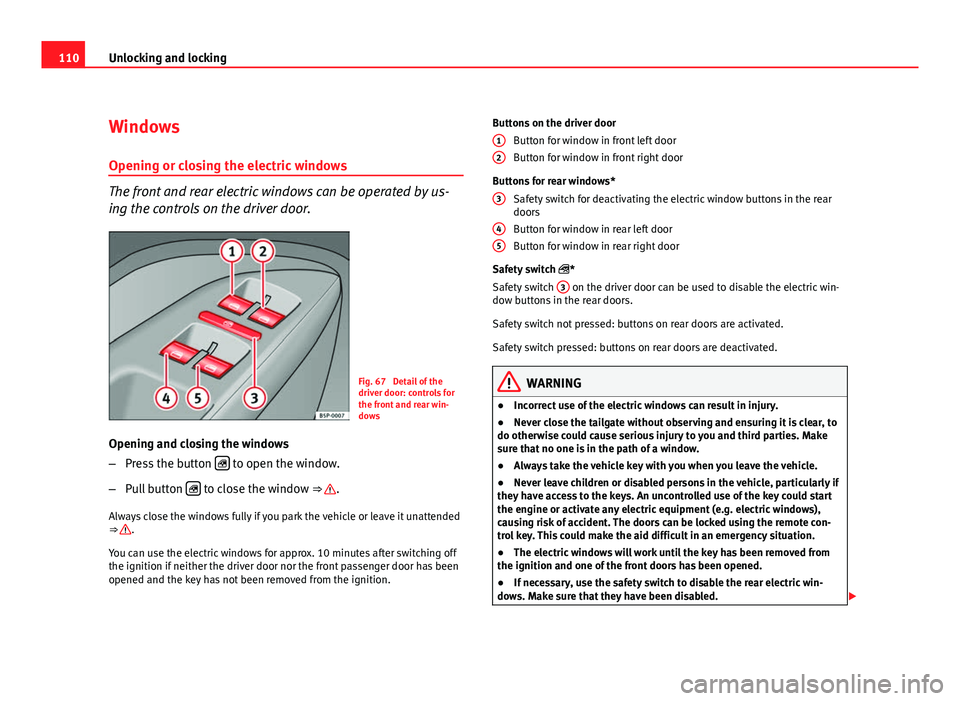
110Unlocking and locking
Windows
Opening or closing the electric windows
The front and rear electric windows can be operated by us-
ing the controls on the driver door.
Fig. 67 Detail of the
driver door: controls for
the front and rear win-
dows
Opening and closing the windows
β Press the button ο΅
to open the window.
β Pull button ο΅
to close the window ββ.
Always close the windows fully if you park the vehicle or leave it unattended
ββ
.
You can use the electric windows for approx. 10 minutes after switching off
the ignition if neither the driver door nor the front passenger door has been
opened and the key has not been removed from the ignition. Buttons on the driver door
Button for window in front left door
Button for window in front right door
Buttons for rear windows* Safety switch for deactivating the electric window buttons in the rear
doors
Button for window in rear left door
Button for window in rear right door
Safety switch ο¦*
Safety switch 3
on the driver door can be used to disable the electric win-
dow buttons in the rear doors.
Safety switch not pressed: buttons on rear doors are activated.
Safety switch pressed: buttons on rear doors are deactivated.
WARNING
β Incorrect use of the electric windows can result in injury.
β Never close the tailgate without observing and ensuring it is clear, to
do otherwise could cause serious injury to you and third parties. Make
sure that no one is in the path of a window.
β Always take the vehicle key with you when you leave the vehicle.
β Never leave children or disabled persons in the vehicle, particularly if
they have access to the keys. An uncontrolled use of the key could start
the engine or activate any electric equipment (e.g. electric windows),
causing risk of accident. The doors can be locked using the remote con-
trol key. This could make the aid difficult in an emergency situation.
β The electric windows will work until the key has been removed from
the ignition and one of the front doors has been opened.
β If necessary, use the safety switch to disable the rear electric win-
dows. Make sure that they have been disabled. ο£
12
3
45
Page 115 of 302
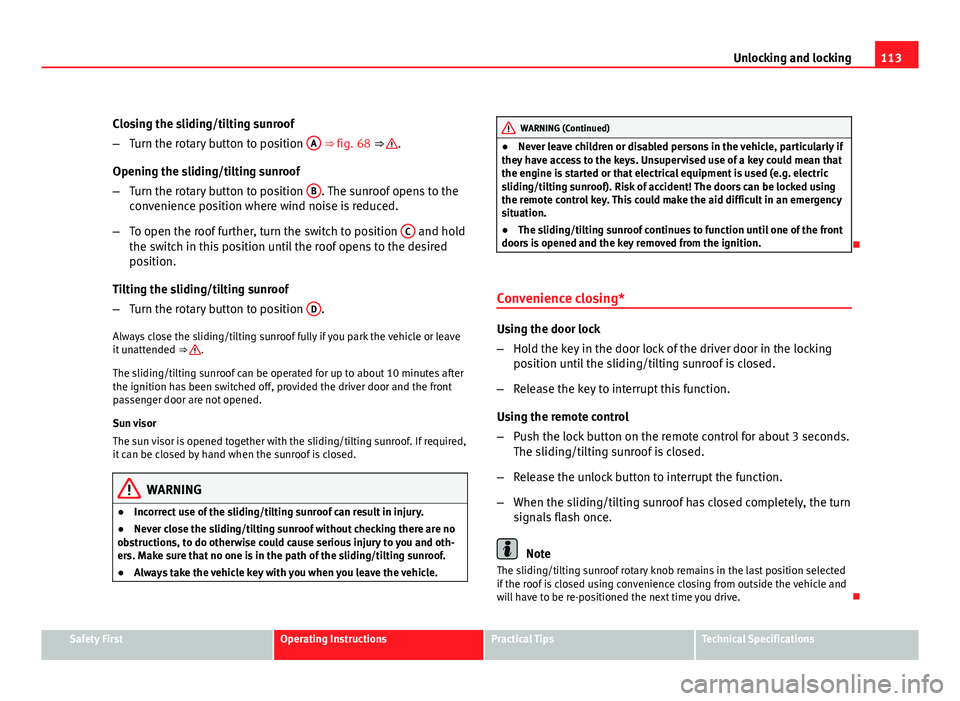
113
Unlocking and locking
Closing the sliding/tilting sunroof
β Turn the rotary button to position A
ββfig. 68 ββ.
Opening the sliding/tilting sunroof
β Turn the rotary button to position B
. The sunroof opens to the
convenience position where wind noise is reduced.
β To open the roof further, turn the switch to position C
and hold
the switch in this position until the roof opens to the desired
position.
Tilting the sliding/tilting sunroof
β Turn the rotary button to position D
.
Always close the sliding/tilting sunroof fully if you park the vehicle or leave
it unattended ββ
.
The sliding/tilting sunroof can be operated for up to about 10 minutes after
the ignition has been switched off, provided the driver door and the front
passenger door are not opened.
Sun visor
The sun visor is opened together with the sliding/tilting sunroof. If required,
it can be closed by hand when the sunroof is closed.
WARNING
β Incorrect use of the sliding/tilting sunroof can result in injury.
β Never close the sliding/tilting sunroof without checking there are no
obstructions, to do otherwise could cause serious injury to you and oth-
ers. Make sure that no one is in the path of the sliding/tilting sunroof.
β Always take the vehicle key with you when you leave the vehicle.
WARNING (Continued)
β Never leave children or disabled persons in the vehicle, particularly if
they have access to the keys. Unsupervised use of a key could mean that
the engine is started or that electrical equipment is used (e.g. electric
sliding/tilting sunroof). Risk of accident! The doors can be locked using
the remote control key. This could make the aid difficult in an emergency
situation.
β The sliding/tilting sunroof continues to function until one of the front
doors is opened and the key removed from the ignition.
ο
Convenience closing*
Using the door lock
β Hold the key in the door lock of the driver door in the locking
position until the sliding/tilting sunroof is closed.
β Release the key to interrupt this function.
Using the remote control
β Push the lock button on the remote control for about 3 seconds.
The sliding/tilting sunroof is closed.
β Release the unlock button to interrupt the function.
β When the sliding/tilting sunroof has closed completely, the turn
signals flash once.
Note
The sliding/tilting sunroof rotary knob remains in the last position selected
if the roof is closed using convenience closing from outside the vehicle and
will have to be re-positioned the next time you drive. ο
Safety FirstOperating InstructionsPractical TipsTechnical Specifications
Page 123 of 302

121
Lights and visibility
3. Switch the engine off.
4. Apply the handbrake.
5. On a manual gearbox engage 1st gear. On an automatic, move the selector lever to P.
6. Use the warning triangle to draw the attention of other road users to your vehicle.
7. Always take the vehicle key with you when you leave the vehi- cle.
Switch on the hazard warning lights to warn other road users, for example
when:
β reaching the tail end of a traffic jam,
β there is an emergency
β your vehicle breaks down due to a technical fault,
β you are towing another vehicle or your vehicle is being towed.
All turn signals flash simultaneously when the hazard warning lights are
switched on. That is that the two turn signal turn signal lamps ο¬ ο and the
turn signal lamp in the switch οΎ will flash at the same time. The hazard
warning lights also work when the ignition is switched off.
Emergency braking warning
If the vehicle is braked suddenly and continuously at a speed of more than
80 km/h, the brake light flashes several times per second to warn vehicles
driving behind. If you continue braking, the hazard warning lights will come
on automatically when the vehicle comes to a standstill. They switch off au-
tomatically when the vehicle starts to move again.
WARNING
β The risk of an accident increases if your vehicle breaks down. Always
use the hazard warning lights and a warning triangle to draw the atten-
tion of other road users to your stationary vehicle.
β Never park where the catalytic converter could come into contact with
inflammable materials under the vehicle, for example dry grass or spilt
petrol. This could start a fire!
Note
β The battery will run down if the hazard warning lights are left on for a
long time, even if the ignition is switched off.
β The use of the hazard warning lights described here is subject to the rel-
evant statutory requirements. ο
Safety FirstOperating InstructionsPractical TipsTechnical Specifications
Page 142 of 302
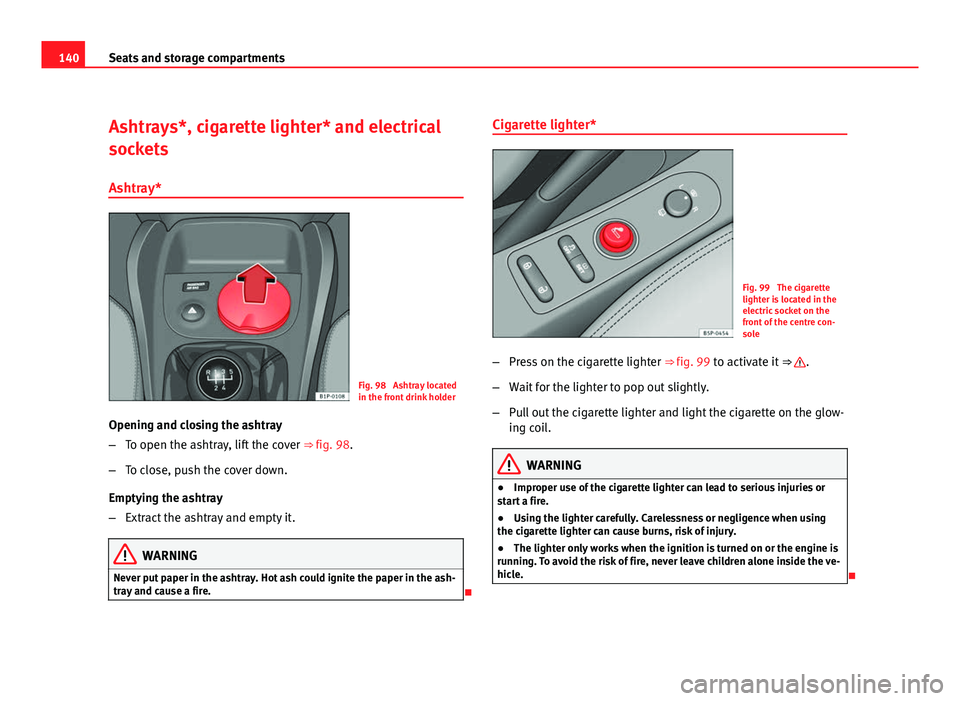
140Seats and storage compartments
Ashtrays*, cigarette lighter* and electrical
sockets
Ashtray*
Fig. 98 Ashtray located
in the front drink holder
Opening and closing the ashtray
β To open the ashtray, lift the cover ββfig. 98.
β To close, push the cover down.
Emptying the ashtray
β Extract the ashtray and empty it.
WARNING
Never put paper in the ashtray. Hot ash could ignite the paper in the ash-
tray and cause a fire.
ο Cigarette lighter*
Fig. 99 The cigarette
lighter is located in the
electric socket on the
front of the centre con-
sole
β Press on the cigarette lighter ββfig. 99 to activate it ββ
.
β Wait for the lighter to pop out slightly.
β Pull out the cigarette lighter and light the cigarette on the glow-
ing coil.
WARNING
β Improper use of the cigarette lighter can lead to serious injuries or
start a fire.
β Using the lighter carefully. Carelessness or negligence when using
the cigarette lighter can cause burns, risk of injury.
β The lighter only works when the ignition is turned on or the engine is
running. To avoid the risk of fire, never leave children alone inside the ve-
hicle.
ο
Page 143 of 302
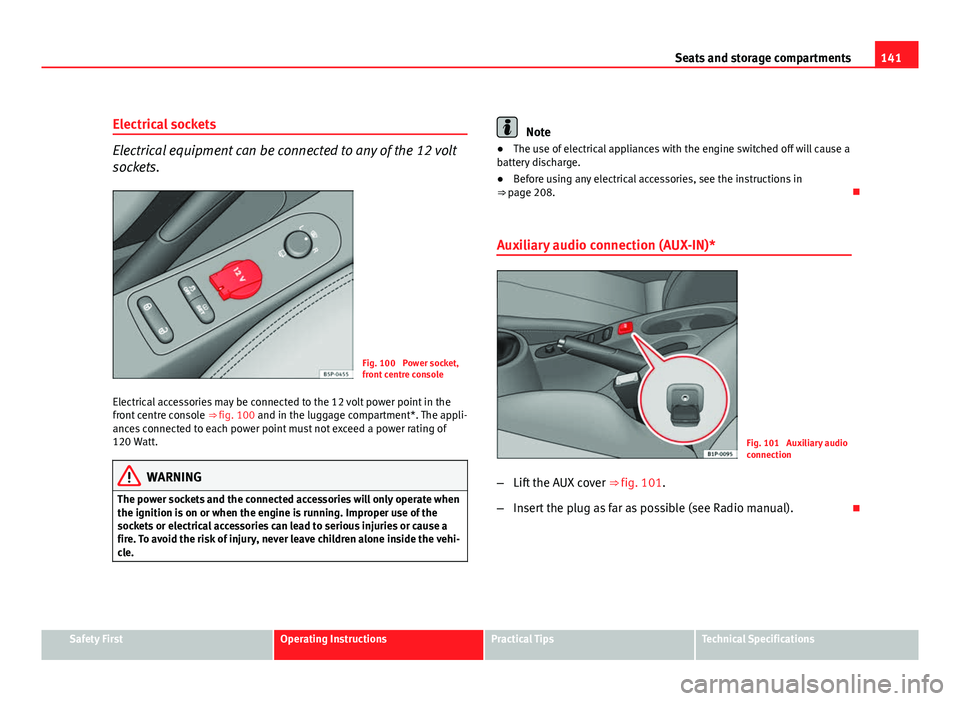
141
Seats and storage compartments
Electrical sockets
Electrical equipment can be connected to any of the 12 volt
sockets.
Fig. 100 Power socket,
front centre console
Electrical accessories may be connected to the 12 volt power point in the
front centre console ββfig. 100 and in the luggage compartment*. The appli-
ances connected to each power point must not exceed a power rating of
120 Watt.
WARNING
The power sockets and the connected accessories will only operate when
the ignition is on or when the engine is running. Improper use of the
sockets or electrical accessories can lead to serious injuries or cause a
fire. To avoid the risk of injury, never leave children alone inside the vehi-
cle.
Note
β The use of electrical appliances with the engine switched off will cause a
battery discharge.
β Before using any electrical accessories, see the instructions in
ββpage 208. ο
Auxiliary audio connection (AUX-IN)*
Fig. 101 Auxiliary audio
connection
β Lift the AUX cover ββfig. 101.
β Insert the plug as far as possible (see Radio manual). ο
Safety FirstOperating InstructionsPractical TipsTechnical Specifications